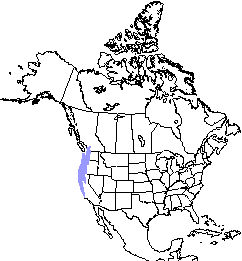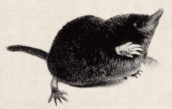|
American shrew-mole Neurotrichus gibbsii 
|
 |
 |
| Identification: Mass: 8-14.5 g Body length: 64-76 mm Tail length: 25-38 mm Colour: black Young: 1-4 per litter Habitat: moist areas in shady ravines and along streambanks Diet: earthworms, insect larvae,sowbugs, snails, slugs, centipedes and variable amounts of fungi and seeds |

|
Distribution: Restricted to western regions of North America from Santa Cruz County, California, and north through western Oregon and Washington. An isolated population occurs on Destruction Island, Washington. In Canada, shrew-moles are restricted to southwestern British Columbia, and were recently reported to occur as far north as the Squamish region. |
| Selected Readings: |
Campbell, K.L. and P.W. Hochachka. 2000. Thermal biology and metabolism of the American shrew-mole, Neurotrichus gibbsii. Journal of Mammalogy, 81(2):578-585. Carraway, L.N. and B.J. Verts. 1991. Neurotrichus gibbsii. Mammalian Species, 129:1-4. Dalquest, W.W. and D.R. Orcutt. 1942. The biology of the least shrew-mole, Neurotrichus gibbsii minor. The American Midland Naturalist, 27:387-401. |

|

